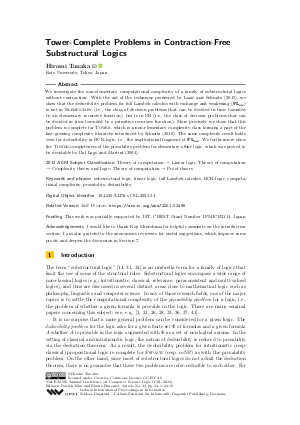@InProceedings{tanaka:LIPIcs.CSL.2023.34,
author = {Tanaka, Hiromi},
title = {{Tower-Complete Problems in Contraction-Free Substructural Logics}},
booktitle = {31st EACSL Annual Conference on Computer Science Logic (CSL 2023)},
pages = {34:1--34:19},
series = {Leibniz International Proceedings in Informatics (LIPIcs)},
ISBN = {978-3-95977-264-8},
ISSN = {1868-8969},
year = {2023},
volume = {252},
editor = {Klin, Bartek and Pimentel, Elaine},
publisher = {Schloss Dagstuhl -- Leibniz-Zentrum f{\"u}r Informatik},
address = {Dagstuhl, Germany},
URL = {https://drops.dagstuhl.de/entities/document/10.4230/LIPIcs.CSL.2023.34},
URN = {urn:nbn:de:0030-drops-174954},
doi = {10.4230/LIPIcs.CSL.2023.34},
annote = {Keywords: substructural logic, linear logic, full Lambek calculus, BCK-logic, computational complexity, provability, deducibility}
}

 Creative Commons Attribution 4.0 International license
Creative Commons Attribution 4.0 International license







